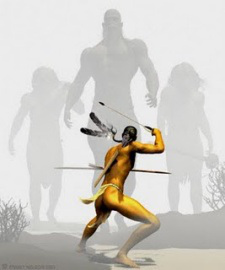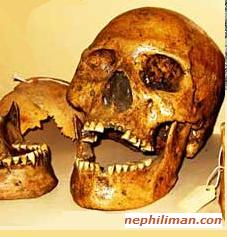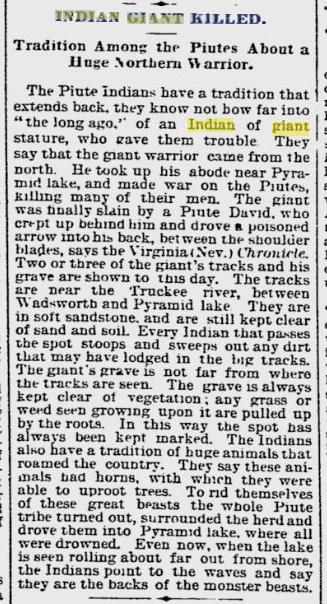
|
Ancient Giants
of Lovelock Cave
The Si-Te-cah Tribe
This is an Archived Version. The updated Article is located at Giants of Lovelock Cave
| |
|
|
The Paiute Indian legends as well as archeological evidence , describes a race of red-haired giants 1 . The Paiute called them the Si-te-cahs. Like their red-haired counterparts , The Ronnongwetowanca and Adena giants of the Ohio River Valley they were exterminated by the smaller but more numerous Paiute
|
|
The Si-te-cahs were a tribe of Indigenous Americans that lived in the Nevada / Arizona area in pre history.
  |
They are extinct, and are most likely not of the same race as Amerindians of modern times. The word "Sitecah" means “tule-eaters” in the Paiute Indian language . Tule is a fibruous water plant, the Si-Te-Cahs towards the end of their existence spent much of their lives on rafts made of tule on Lake Lahontan to avoid harassment from the Paiute.
The last known group had their home in lovelock cave where their remains were discovered in 1911. [Although the word Si-te-cah only applies to the tribe that the Paiute legends speak of, I have applied it to other related peoples and traces of peoples throughout the same vicinity.]
|
|
Native Legends
 |
The Paiute Indian legends describe a race of red-haired giants called Si-te-cahs. Like their red-haired counterparts , The Ronnongwetowanca and Adena giants of the Ohio River Valley {See: The Mound Builders}, The Si-te-cahs were the enemies of many Indian tribes of the region. also according to the Paiutes, the Si-Te-Cah were hostile and warlike and practiced cannibalism.
|
 |
The Unexplained: An Illustrated Guide to the World's Natural and Paranormal Mysteries reports that in 1911, Guano [bat excrement] miners discovered a treasure trove of prehistoric artifacts at Lovelock Cave, [the same cave in which per Paiute legend states was where the Si-te-cah were slaughtered] above the southeastern shore of Humboldt Sink. reports that in 1911, Guano [bat excrement] miners discovered a treasure trove of prehistoric artifacts at Lovelock Cave, [the same cave in which per Paiute legend states was where the Si-te-cah were slaughtered] above the southeastern shore of Humboldt Sink.
The Si-Te-Cah and the Paiutes were at war, and after a long struggle a coalition of tribes trapped the remaining Si-Te-Cah in Lovelock Cave. When they refused to come out and be slaughtered, the Indians piled brush before the mouth of lovelock cave and set it on fire, annihilating The Si-Te-Cah
Paiute legends also have the Si-Te-Cah building a pyramidal stone structure in New York Canyon, some miles away in Churchill County, The area is known for earthquakes and if the pyramid existed it probably collapsed over the years.
|
Lovelock Cave
  |
"My people say that the tribe we exterminated had reddish hair. I have some of their hair, which has been handed down from father to son. I have a dress which has been in our family a great many years, trimmed with the reddish hair. I am going to wear it some time when I lecture. It is called a mourning dress, and no one has such a dress but my family."
Sarah Winnemucca Hopkins Life Among the Piutes: Their Wrongs and Claims
|
|
 Archaeologists from the Nevada Historical Society and the University of California believe the cave was occupied from approximately 1500 B.C. until a few hundred years before the white man appeared in the region . Red-haired mummies and skeletal remains ranging from 6 and a half feet to 8 feet tall were discovered in lovelock cave . Some skulls recovered from Lovelock Cave can still be seen in museums in Lovelock and Winnemucca, Nevada. Archaeologists from the Nevada Historical Society and the University of California believe the cave was occupied from approximately 1500 B.C. until a few hundred years before the white man appeared in the region . Red-haired mummies and skeletal remains ranging from 6 and a half feet to 8 feet tall were discovered in lovelock cave . Some skulls recovered from Lovelock Cave can still be seen in museums in Lovelock and Winnemucca, Nevada.
|
|
In 1931, more large skeletons were found in the Humboldt lake bed [ Humbolt lake bed / Sink is an intermittent dry lake bed, approximately 11 miles by 4 mi across, in northwestern Nevada], approximately 20 miles from Lovelock, Nevada. The first of these two skeletons found measured 8 1/2 feet tall and appeared to have been wrapped in a gum-covered fabric similar to the Egyptian manner. The second skeleton was almost 10 feet long. (Review - Miner, June 19, 1931). The Review Miner of Sept. 29, 1939 reported another finding of a 7 foot 7 inch skeleton , also near Lovelock, Nevada. Humboldt lake bed was once part of an ancient lake known as Lake Lahontan .
|
|
Suggested Reading
|


|
"It is time to consider the third, last, and most highly interesting class of Antiquities, which comprehends those belonging to that people who erected our ancient forts and tumuli; those military works, whose walls and ditches cost so much labour, in their structure, those numerous and sometimes lofty mounds, which owe their origin to a people far more civilized than our Indians, but far less so than Europeans. These works are interesting, on many accounts, to the Antiquarian, the Philosopher, and the Divine, especially when we consider the immense extent of country which they cover .. " Caleb Atwater {1778 -1867}
|
    
|
|